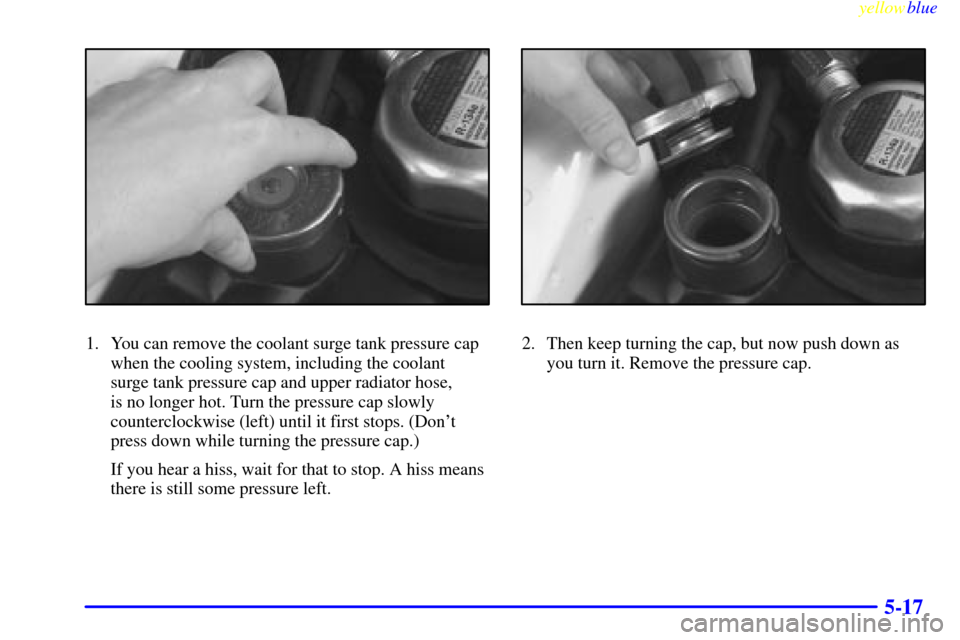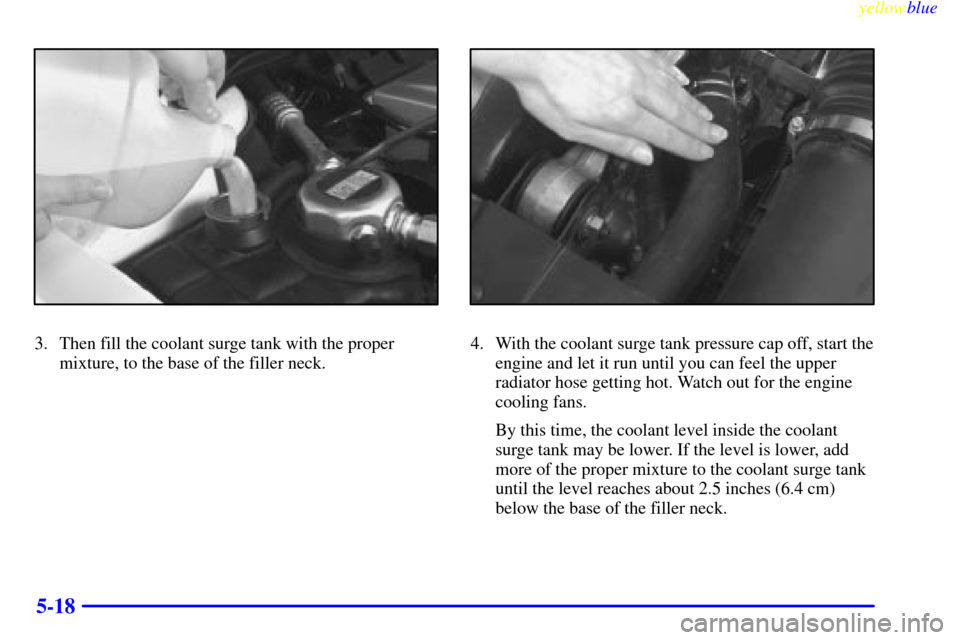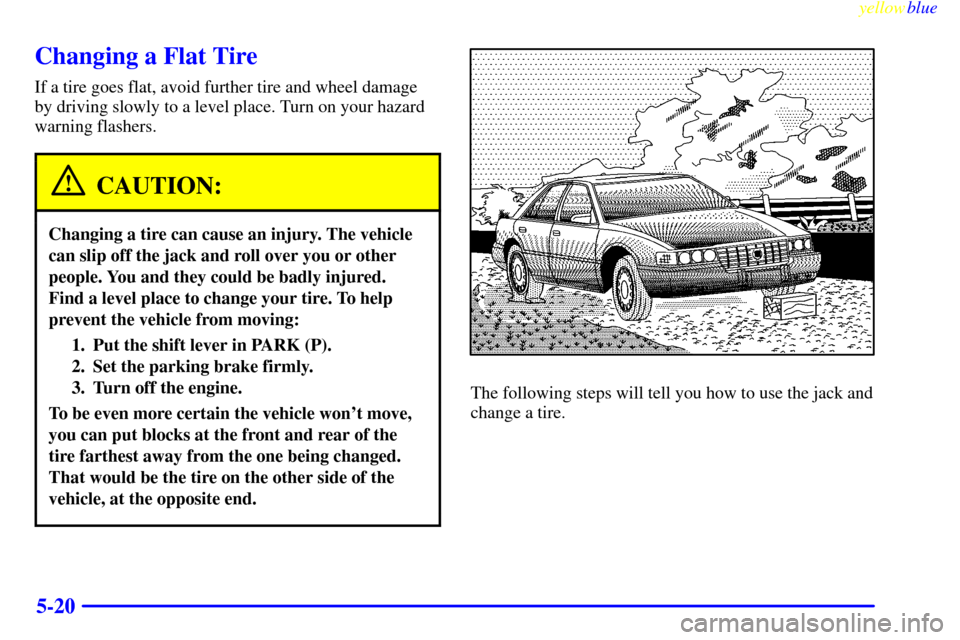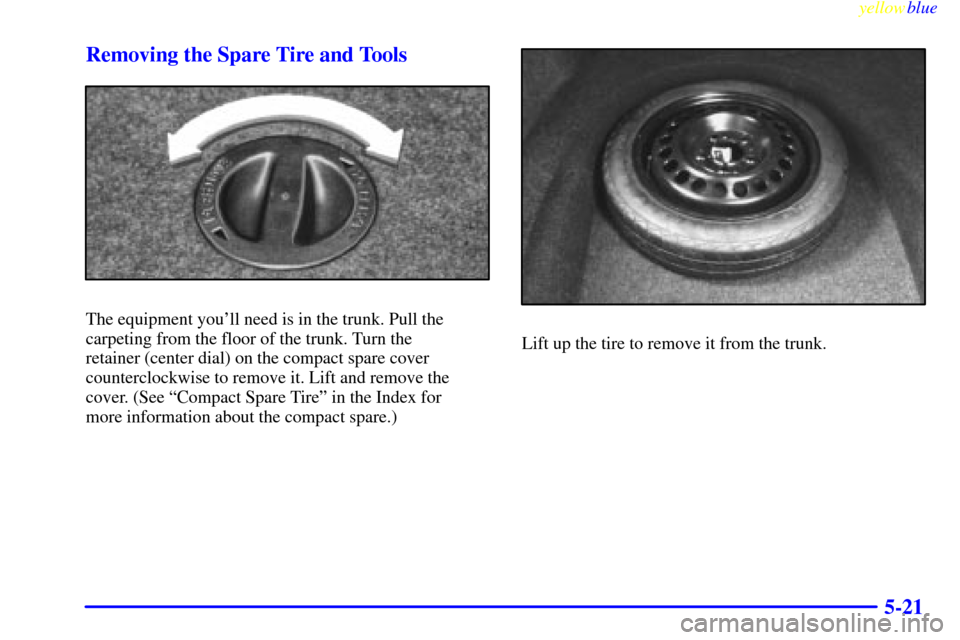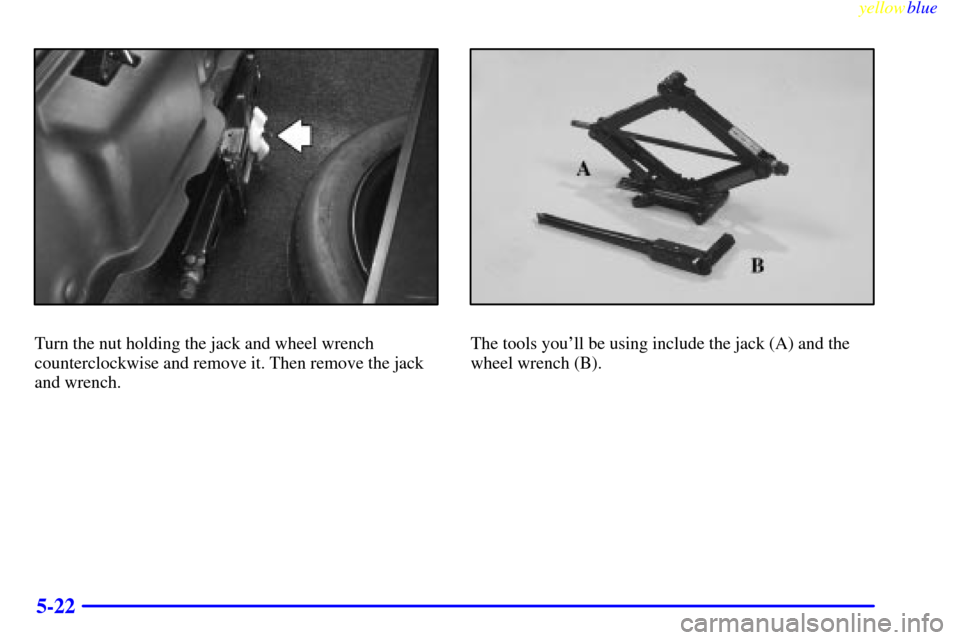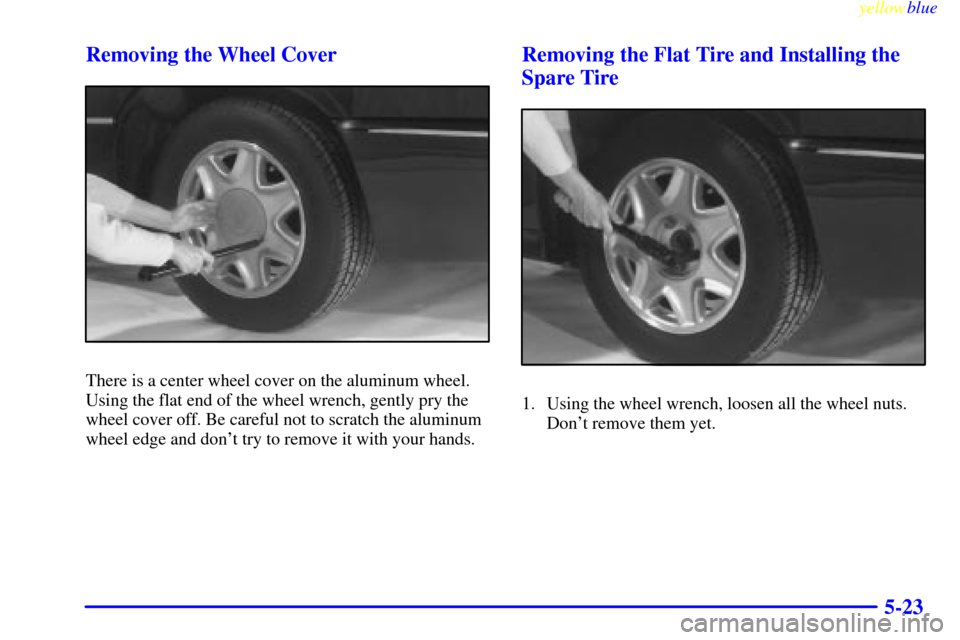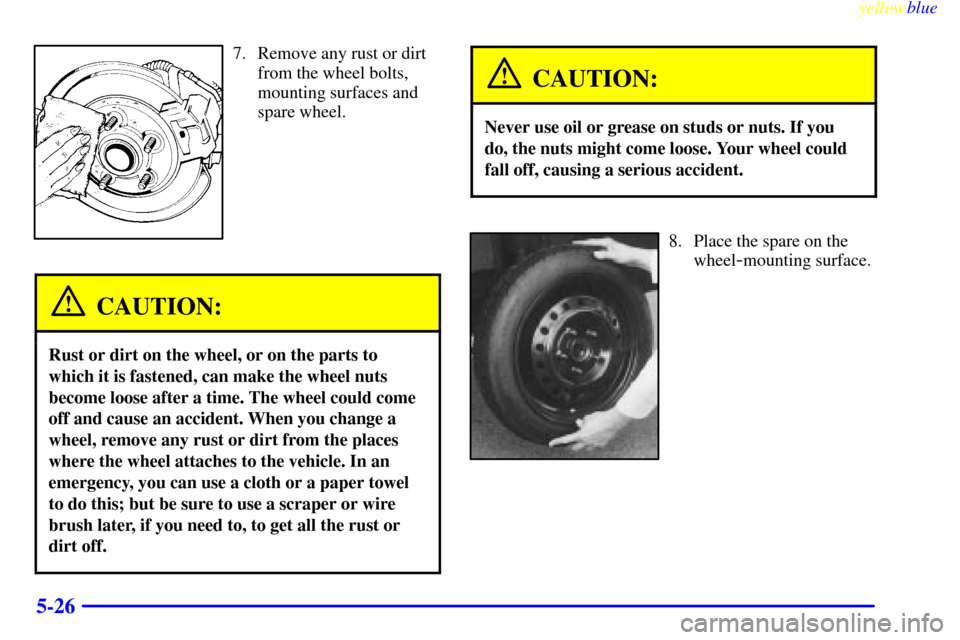CADILLAC ELDORADO 1999 10.G Owners Manual
ELDORADO 1999 10.G
CADILLAC
CADILLAC
https://www.carmanualsonline.info/img/23/7901/w960_7901-0.png
CADILLAC ELDORADO 1999 10.G Owners Manual
Trending: cooling, washer fluid, glove box, spare tire, run flat, warning, clutch
Page 231 of 344
yellowblue
5-17
1. You can remove the coolant surge tank pressure cap
when the cooling system, including the coolant
surge tank pressure cap and upper radiator hose,
is no longer hot. Turn the pressure cap slowly
counterclockwise (left) until it first stops. (Don't
press down while turning the pressure cap.)
If you hear a hiss, wait for that to stop. A hiss means
there is still some pressure left.2. Then keep turning the cap, but now push down as
you turn it. Remove the pressure cap.
Page 232 of 344
yellowblue
5-18
3. Then fill the coolant surge tank with the proper
mixture, to the base of the filler neck.4. With the coolant surge tank pressure cap off, start the
engine and let it run until you can feel the upper
radiator hose getting hot. Watch out for the engine
cooling fans.
By this time, the coolant level inside the coolant
surge tank may be lower. If the level is lower, add
more of the proper mixture to the coolant surge tank
until the level reaches about 2.5 inches (6.4 cm)
below the base of the filler neck.
Page 233 of 344
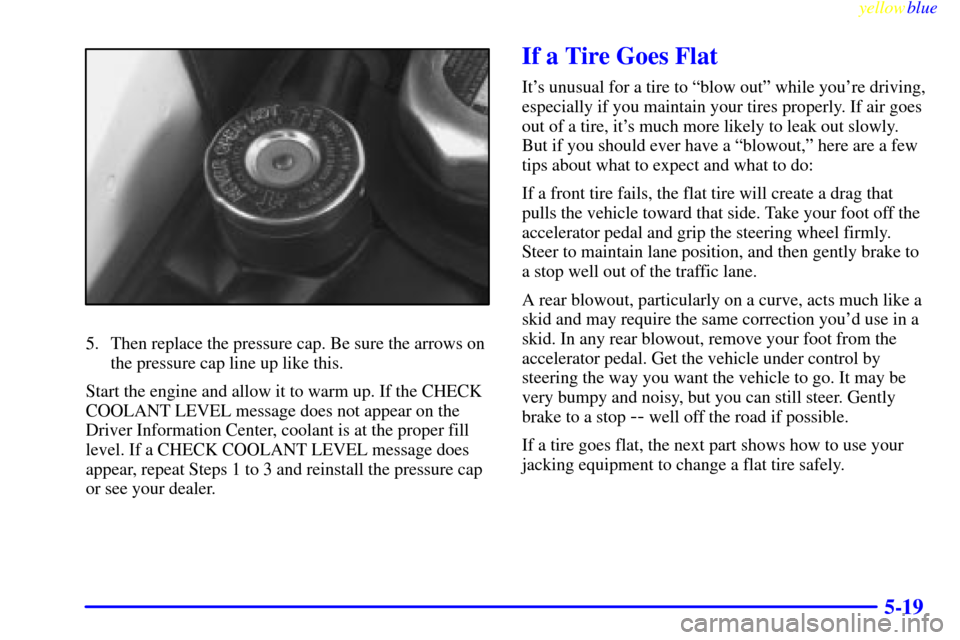
yellowblue
5-19
5. Then replace the pressure cap. Be sure the arrows on
the pressure cap line up like this.
Start the engine and allow it to warm up. If the CHECK
COOLANT LEVEL message does not appear on the
Driver Information Center, coolant is at the proper fill
level. If a CHECK COOLANT LEVEL message does
appear, repeat Steps 1 to 3 and reinstall the pressure cap
or see your dealer.
If a Tire Goes Flat
It's unusual for a tire to ªblow outº while you're driving,
especially if you maintain your tires properly. If air goes
out of a tire, it's much more likely to leak out slowly.
But if you should ever have a ªblowout,º here are a few
tips about what to expect and what to do:
If a front tire fails, the flat tire will create a drag that
pulls the vehicle toward that side. Take your foot off the
accelerator pedal and grip the steering wheel firmly.
Steer to maintain lane position, and then gently brake to
a stop well out of the traffic lane.
A rear blowout, particularly on a curve, acts much like a
skid and may require the same correction you'd use in a
skid. In any rear blowout, remove your foot from the
accelerator pedal. Get the vehicle under control by
steering the way you want the vehicle to go. It may be
very bumpy and noisy, but you can still steer. Gently
brake to a stop
-- well off the road if possible.
If a tire goes flat, the next part shows how to use your
jacking equipment to change a flat tire safely.
Page 234 of 344
yellowblue
5-20
Changing a Flat Tire
If a tire goes flat, avoid further tire and wheel damage
by driving slowly to a level place. Turn on your hazard
warning flashers.
CAUTION:
Changing a tire can cause an injury. The vehicle
can slip off the jack and roll over you or other
people. You and they could be badly injured.
Find a level place to change your tire. To help
prevent the vehicle from moving:
1. Put the shift lever in PARK (P).
2. Set the parking brake firmly.
3. Turn off the engine.
To be even more certain the vehicle won't move,
you can put blocks at the front and rear of the
tire farthest away from the one being changed.
That would be the tire on the other side of the
vehicle, at the opposite end.
The following steps will tell you how to use the jack and
change a tire.
Page 235 of 344
yellowblue
5-21 Removing the Spare Tire and Tools
The equipment you'll need is in the trunk. Pull the
carpeting from the floor of the trunk. Turn the
retainer (center dial) on the compact spare cover
counterclockwise to remove it. Lift and remove the
cover. (See ªCompact Spare Tireº in the Index for
more information about the compact spare.)
Lift up the tire to remove it from the trunk.
Page 236 of 344
yellowblue
5-22
Turn the nut holding the jack and wheel wrench
counterclockwise and remove it. Then remove the jack
and wrench.The tools you'll be using include the jack (A) and the
wheel wrench (B).
Page 237 of 344
yellowblue
5-23 Removing the Wheel Cover
There is a center wheel cover on the aluminum wheel.
Using the flat end of the wheel wrench, gently pry the
wheel cover off. Be careful not to scratch the aluminum
wheel edge and don't try to remove it with your hands.
Removing the Flat Tire and Installing the
Spare Tire
1. Using the wheel wrench, loosen all the wheel nuts.
Don't remove them yet.
Page 238 of 344
yellowblue
5-24
2. Find the jacking location from the diagram above
and corresponding cutouts in the plastic molding.
Page 239 of 344
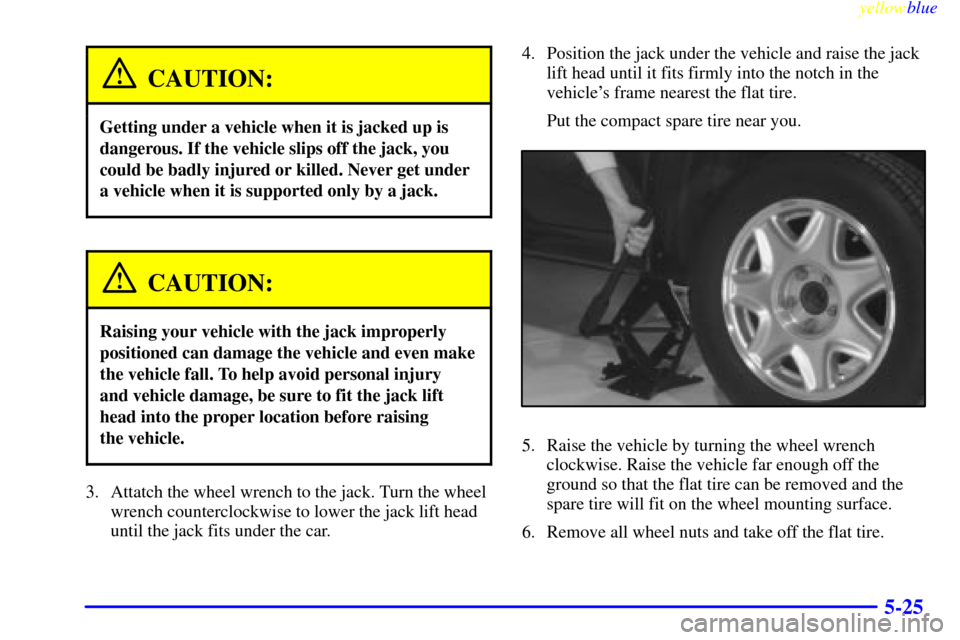
yellowblue
5-25
CAUTION:
Getting under a vehicle when it is jacked up is
dangerous. If the vehicle slips off the jack, you
could be badly injured or killed. Never get under
a vehicle when it is supported only by a jack.
CAUTION:
Raising your vehicle with the jack improperly
positioned can damage the vehicle and even make
the vehicle fall. To help avoid personal injury
and vehicle damage, be sure to fit the jack lift
head into the proper location before raising
the vehicle.
3. Attatch the wheel wrench to the jack. Turn the wheel
wrench counterclockwise to lower the jack lift head
until the jack fits under the car.4. Position the jack under the vehicle and raise the jack
lift head until it fits firmly into the notch in the
vehicle's frame nearest the flat tire.
Put the compact spare tire near you.
5. Raise the vehicle by turning the wheel wrench
clockwise. Raise the vehicle far enough off the
ground so that the flat tire can be removed and the
spare tire will fit on the wheel mounting surface.
6. Remove all wheel nuts and take off the flat tire.
Page 240 of 344
yellowblue
5-26
7. Remove any rust or dirt
from the wheel bolts,
mounting surfaces and
spare wheel.
CAUTION:
Rust or dirt on the wheel, or on the parts to
which it is fastened, can make the wheel nuts
become loose after a time. The wheel could come
off and cause an accident. When you change a
wheel, remove any rust or dirt from the places
where the wheel attaches to the vehicle. In an
emergency, you can use a cloth or a paper towel
to do this; but be sure to use a scraper or wire
brush later, if you need to, to get all the rust or
dirt off.
CAUTION:
Never use oil or grease on studs or nuts. If you
do, the nuts might come loose. Your wheel could
fall off, causing a serious accident.
8. Place the spare on the
wheel
-mounting surface.
Trending: horn, coolant level, parking brake, washer fluid, wheel size, oil capacity, seats
